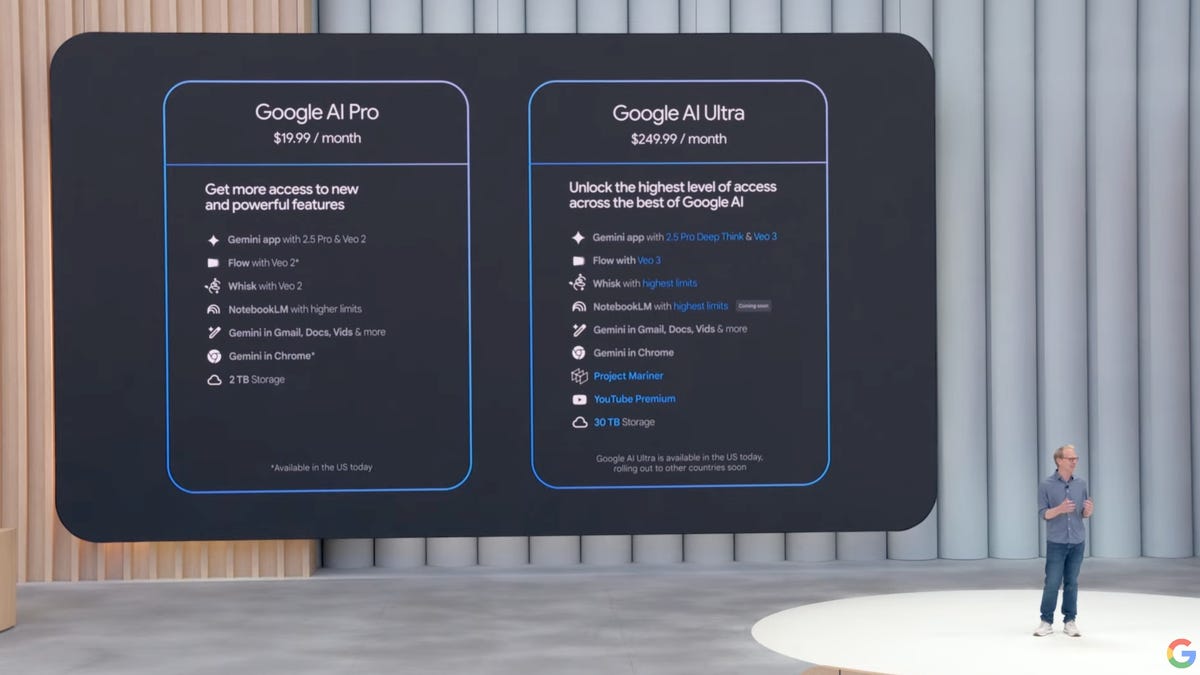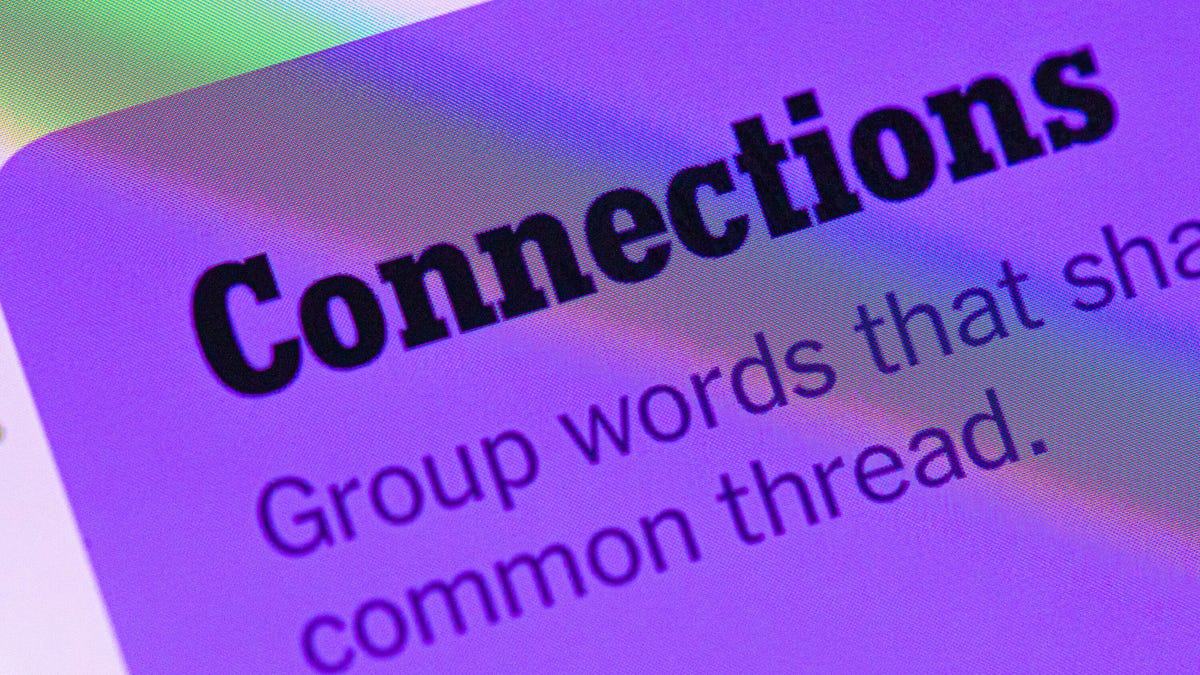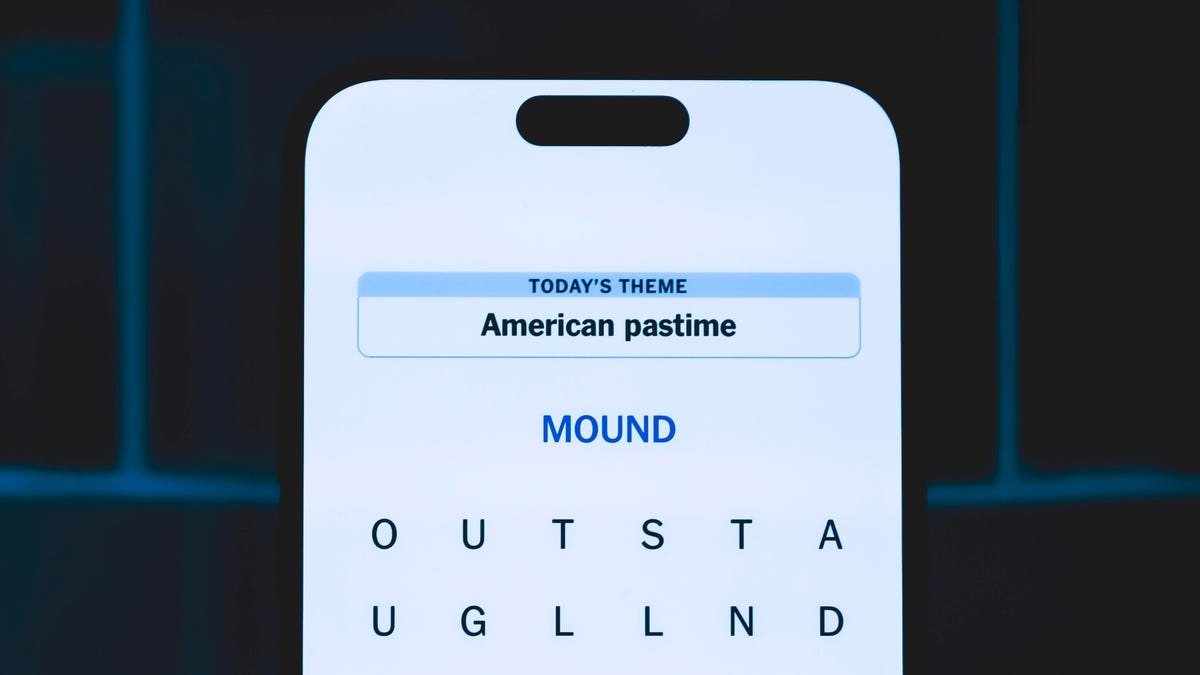Technologies
Who the Heck Is Gonna Pay $250 for Google AI Ultra?
Google’s pricey new AI subscription seems to be aimed at people who want to generate a ton of video or code.

Want Google’s biggest and best AI features? A new plan has them all, but with a steep price tag.
Read more: Everything We Learned at Google I/O. AI Mode in Chrome, Gemini Live, XR Glasses and Much More
Google rolled out AI Ultra Tuesday at its annual I/O developers conference, and the new top-tier model features the best models of its Gemini tool, early access to new video generation models, the highest usage limits in tools like NotebookLM, a prototype for managing AI agents and, as icing on the cake, a whopping 30 terabytes of storage.
For all of that, you’ll pay a pretty penny. Google AI Ultra costs $250 a month (although the company is offering half off the first three months). Not ready to drop $3,000 a year on AI? Google is rebranding its existing AI Premium plan as Google AI Pro, which also offers new features. It stays at a modest $20 per year.
The difference between the two plans centers mainly on the usage limits for AI tools and access to bleeding-edge technology. Google AI Ultra has much higher limits, meaning if you’re making a ton of videos or using Gemini a ton, you might need the pricier option. «It’s for the trailblazers, the pioneers, those of you who want cutting-edge AI from Google,» Josh Woodward, the company’s vice president for Google Labs and Gemini, said during Tuesday’s announcement.
Here’s what’s included in the new Google AI plans.
What’s in the Google AI Ultra plan?
The biggest component of Google AI Ultra is a maxed-out version of the company’s Gemini app. It has the highest usage limits for the Deep Research function, along with the Veo 2 video generation model and early access to Veo 3. The subscription also includes the company’s newest reasoning model, Deep Think in Gemini 2.5 pro. You’ll also get immediate early access to Gemini in Chrome, which allows you to use Gemini to understand information based on the context of the current page you’re on.
AI Ultra features access to Flow, Google’s new AI filmmaking tool that also debuted at I/O. This tool allows you to create clips, scenes and movies with text and image prompts. AI Ultra gets you the highest limits for Flow. (The AI Pro plan also includes access to Flow, just with a limit of 100 generations per month.) It also includes the highest limits for Whisk, an AI image generator that allows you to turn photos into mashups, including Whisk Animate, which creates vivid eight-second videos.
Other features included in AI Ultra aren’t necessarily AI-specific: You’ll get access to YouTube Premium, including YouTube Music ad-free. It also includes 30TB worth of cloud storage. It’s only available in the US for now.
While AI Ultra’s $250 monthly price tag is high, compare it to the top-tier subscription plans from competing AI companies. OpenAI’s Pro plan gives you the best of ChatGPT for $200 per month. Anthropic’s Max plan starts at $100 per month for top Claude features.
What’s in Google AI Pro?
The company’s current AI Premium plan is being renamed AI Pro. The price remains $20 per month, but the new features include Flow’s filmmaking capabilities and early access to Gemini in Chrome. These additions are also coming to the US first.
Google said it is also expanding free access to AI Pro for university students in Japan, Brazil, Indonesia and the United Kingdom. It’s already available free for students in the US.
Who is Google AI Ultra for?
You don’t need to drop $250 a month on AI if you’re just dabbling around with chatbots or making an image or two occasionally. Google’s AI Pro plan likely has everything you’ll need at a much better price.
What about the bundlers who want a lot of storage space? The non-AI features of AI Ultra are pretty cool, but are they worth $250 a month? First there’s YouTube Premium, which only costs $14 a month on its own. You can pair that with Google AI pro for just $34 a month. (And if you want to use a different AI service, even a top-level plan from OpenAI or Anthropic would keep your total below $250.) As for the 30TB of storage, that’s harder to replace. Apple’s iCloud offers 12TB for $60 a month while Dropbox offers 15TB starting at $24 per month.
The distinction really is the usage limits and the cutting-edge features. Google representatives told me that AI Ultra is best for people like filmmakers, developers and creatives who are going to generate a lot of content using AI. If you want to use generative AI to produce a lot of video content or longform video content, you’ll need the highest usage limits you can get. And with all of those files, you might actually need that 30TB of storage.
Even if you’re not using AI to produce a ton of content, you may be interested in AI Ultra if you absolutely must have access to the new features as soon as they roll out. AI Ultra will get early access to things like Google’s Project Mariner agentic research tool and the new Deep Think feature in Gemini.
But if the price tag for the biggest and best subscription plan is giving you sticker shock, don’t worry. AI Pro still comes with plenty of features.
Technologies
Meta Wins Antitrust Case, Won’t Have to Give Up WhatsApp or Instagram
The FTC claimed Meta held an illegal monopoly in social networking.

Meta has won its antitrust case against the Federal Trade Commission. The FTC said Meta held an illegal monopoly in social networking — centering on the company’s acquisitions of WhatsApp and Instagram.
Judge James Boasberg of the US District Court for the District of Columbia released a memorandum opinion on Tuesday, stating that the FTC failed to prove its claims in court.
Don’t miss any of our unbiased tech content and lab-based reviews. Add CNET as a preferred Google source.
«Whether or not Meta enjoyed monopoly power in the past,» Boasberg wrote in the filing, «the agency must show that it continues to hold such power now.»
Boasberg initially dismissed the FTC’s complaint in 2021, stating that the agency lacked sufficient evidence that Meta holds «market power» in the social networking industry. At the time, the FTC argued that «Facebook’s course of conduct has eliminated nascent rivals,» preventing «the benefits of competition, including increased choice, quality and innovation» from developing for US social media users.
After the FTC amended its filing with information about Meta’s user numbers and acquisitions of the WhatsApp and Instagram applications, Boasberg allowed the case to proceed in 2022.
The trial began in April, and multiple high-ranking current and former Meta executives testified before the court — chief among them, Meta CEO Mark Zuckerberg. Much of Zuckerberg’s testimony focused on refuting the FTC’s primary claim, which hinged on an argument Zuckerberg made in 2008: «It is better to buy than compete.»
Meta’s win means the company will be able to continue operating WhatsApp and Instagram unimpeded. Had the FTC proven its claims in court, Meta likely would have had to break these applications off into their own separate social networking companies.
Meta released a public statement on Tuesday, stating that the decision «recognizes that Meta faces fierce competition» in the social networking industry.
«Our products are beneficial for people and businesses and exemplify American innovation and economic growth,» the statement read. «We look forward to continuing to partner with the Administration and to invest in America.»
FTC Director of Public Affairs Joe Simonson said the agency is «deeply disappointed» with the outcome of the case.
«The deck was always stacked against us with Judge Boasberg, who is currently facing articles of impeachment,» he said. «We are reviewing all our options.»
Republican lawmakers have tried multiple times to impeach Boasberg, a frequent political target of the Trump administration.
While Meta’s antitrust case may be over, it didn’t take place in a vacuum. Google recently settled a case with the FTC that resulted in the search giant being told it must share limited search and user-interaction data with «qualified competitors.» Another case targeting Google’s AI overview feature is ongoing in the European Union, as a group of publishers claims the company is causing harm due to a loss of traffic, readership, and revenue.
Technologies
Today’s NYT Connections Hints, Answers and Help for Nov. 19, #892
Here are some hints and the answers for the NYT Connections puzzle for Nov. 19, #892

Looking for the most recent Connections answers? Click here for today’s Connections hints, as well as our daily answers and hints for The New York Times Mini Crossword, Wordle, Connections: Sports Edition and Strands puzzles.
Today’s NYT Connections puzzle has one of those classic purple categories, where four words have hidden connected words inside them. If you need help sorting them into groups, you’re in the right place. Read on for clues and today’s Connections answers.
The Times now has a Connections Bot, like the one for Wordle. Go there after you play to receive a numeric score and to have the program analyze your answers. Players who are registered with the Times Games section can now nerd out by following their progress, including the number of puzzles completed, win rate, number of times they nabbed a perfect score and their win streak.
Read more: Hints, Tips and Strategies to Help You Win at NYT Connections Every Time
Hints for today’s Connections groups
Here are four hints for the groupings in today’s Connections puzzle, ranked from the easiest yellow group to the tough (and sometimes bizarre) purple group.
Yellow group hint: Not petite.
Green group hint: You learn this in driver’s ed.
Blue group hint: Nevermore!
Purple group hint: Look for hidden words having to do with the body.
Answers for today’s Connections groups
Yellow group: Stocky.
Green group: Steer.
Blue group: Second words in Poe stories, after «The.»
Purple group: Organ plus a letter.
Read more: Wordle Cheat Sheet: Here Are the Most Popular Letters Used in English Words
What are today’s Connections answers?
The yellow words in today’s Connections
The theme is stocky. The four answers are husky, solid, squat and thick.
The green words in today’s Connections
The theme is steer. The four answers are direct, guide, lead and shepherd.
The blue words in today’s Connections
The theme is second words in Poe stories, after «The.» The four answers are cask, fall, masque and pit.
The purple words in today’s Connections
The theme is organ plus a letter. The four answers are colony (colon), hearth (heart), lunge (lung) and skink (skin).
Technologies
Today’s NYT Strands Hints, Answers and Help for Nov. 19 #626
Here are hints and answers for the NYT Strands puzzle for Nov. 19, No. 626.

Looking for the most recent Strands answer? Click here for our daily Strands hints, as well as our daily answers and hints for The New York Times Mini Crossword, Wordle, Connections and Connections: Sports Edition puzzles.
Today’s NYT Strands puzzle is easier than most days. It helps if you know world religions. Some of the answers are difficult to unscramble, so if you need hints and answers, read on.
I delve into the rules for Strands in this story.
If you’re looking for today’s Wordle, Connections and Mini Crossword answers, you can visit CNET’s NYT puzzle hints page.
Read more: NYT Connections Turns 1: These Are the 5 Toughest Puzzles So Far
Hint for today’s Strands puzzle
Today’s Strands theme is: Divinely inspired.
If that doesn’t help you, here’s a clue: Different beliefs.
Clue words to unlock in-game hints
Your goal is to find hidden words that fit the puzzle’s theme. If you’re stuck, find any words you can. Every time you find three words of four letters or more, Strands will reveal one of the theme words. These are the words I used to get those hints, but any words of four or more letters that you find will work:
- BRIM, BEAR, PEST, RIGS, ROPE, GRIP, GRIPE, GOES, GUILE, MAIM, GRAD
Answers for today’s Strands puzzle
These are the answers that tie into the theme. The goal of the puzzle is to find them all, including the spangram, a theme word that reaches from one side of the puzzle to the other. When you have all of them (I originally thought there were always eight but learned that the number can vary), every letter on the board will be used. Here are the nonspangram answers:
- IMAM, RABBI, PRIEST, MONK, BUDDHA, PROPHET
Today’s Strands spangram
Today’s Strands spangram is RELIGIOUSFIGURES. To find it, start with the R that’s three letters to the right on the bottom row, and wind up.
-

 Technologies3 года ago
Technologies3 года agoTech Companies Need to Be Held Accountable for Security, Experts Say
-

 Technologies3 года ago
Technologies3 года agoBest Handheld Game Console in 2023
-

 Technologies3 года ago
Technologies3 года agoTighten Up Your VR Game With the Best Head Straps for Quest 2
-

 Technologies4 года ago
Technologies4 года agoBlack Friday 2021: The best deals on TVs, headphones, kitchenware, and more
-

 Technologies4 года ago
Technologies4 года agoVerum, Wickr and Threema: next generation secured messengers
-

 Technologies4 года ago
Technologies4 года agoGoogle to require vaccinations as Silicon Valley rethinks return-to-office policies
-

 Technologies4 года ago
Technologies4 года agoOlivia Harlan Dekker for Verum Messenger
-

 Technologies4 года ago
Technologies4 года agoiPhone 13 event: How to watch Apple’s big announcement tomorrow
